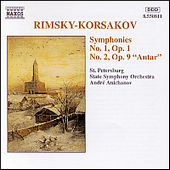Symphony No. 1 in E Minor, Op. 1/Rimsky-Korsakov
August 12, 2010
Ten years before Rimsky-Korsakov undertook teaching at St. Petersburg Conservatory and still in Cadet School he undertook the writing of his first symphony, with the guidance of Balakirev. “The introduction and the exposition of the subjects (up to the development) were subjected to considerable criticism by Balakirev” Rimsky-Korsakov wrote in his autobiography My Musical Life. The second movement is a folk-song “On the Tartar Captivity” provided by his teacher and mentor. In 1865 when he was transferred to a life in St. Petersburg he finally completed it having worked for a total of four years on his first opus and it premiered at the Free Music School in 1865 by Balakirev in the original key of E Flat Minor. Had this version been performed one could certainly be impressed with work from a 17 year old. However, this version is seldom performed and what we hear today, is a revision from 20 years later in a more manageable key of E Minor, from 1884. While Rimsky-Korsakov considered it a student piece it was still published by Bessel’s firm. To my knowledge there is no known recording of the work in E Flat Minor. With the additional 20 years of experience Rimsky-Korsakov certainly put his orchestral techniques to good use and while it is not what one would call a great symphony it certainly has some merit.
Upon examination this is certainly a lot more mature work and while it really doesn’t have that Rimsky-Korsakov sound, likely way too early on in his career, it is certainly one worth exploring. As time went on his understanding of the brass section improved considerably as well as his use of counterpoint and a more complicated but listenable harmony. The Naxos recording 8.550811 couples it with his far more popular “Antar” symphony/symphonic suite and the pair are a nice combination for a CD. Couple this as always with the attractive price Naxos has to offer and you have a good choice.
The scherzo is really quite good melody, very upbeat and could easily be a nice stand alone work on its own. The other three movements in this symphony are extremely Russian sounding, stoic and solemn in nature so much so you couldn’t mistake it for any other country. If a movie producer wanted to use sections of this symphony as source material it would easily let one know what country you wanted to think of.
As I’ve discussed in prior reviews the Jarvi/Gothenburg Symphony Orchestra two CD set it is a good value for you if you want Capriccio Espagnol and Russian Easter Overture as well as the three symphonies. I found the first movement of the first symphony to be too quick to my liking, 7:30 compared to 8:46 for Anichanov/St. Petersburg Orchestra. The major advantage of the Jarvi set is the superior recording and engineering, slightly superior to the Chandos.
The (5) CD set from Svetlanov offers a considerably slower pace, nearly 4 minutes longer, much of the difference being in the second movement the Andante. Svetlanov and the Russian orchestra certainly know how to play their music. They just have the right feel and you can hear it in the performance. However, price plays a price in this 5 CD set and you’d have to want all his orchestral material. The engineering and remastering are adequate, not up to the standards of the Naxos, DG, and Chandos recordings.
Kitajenko and the Bergen Philharmonic offer a very attractive package recorded nicely by Chandos and now available on their medium priced series. What it lacks in feeling is more than made up for in the excellent engineering from the Chandos group. Again the offering includes some of his major works and would be a good value if one were looking for more than just the 1st Symphony.
The Butt reading with the London Philharmonia Orchestra has a lack luster performance and recording and is not a recording I could recommend unless it was available at a bargain price, certainly not the case these days with the now defunct ASV label. The intensity offered by other recordings is just not there.
Setting aside the fact that he revised the work 20 years later this is an excellent example of a first work for a composer, in fact this has to be included at the top of list for Opus No. 1 material.
Discography of Reviewed Recordings
1….Neeme Jarvi conducting the Gothenburg Symphony Orchestra (DG423-604-2). A 2CD set which also includes his other 2 Symphonies, Capriccio Espagnol and Russian Easter Festival Overture. DDD recording from 1988.
2….Andre Anichanov conducting the St. Petersburg State Symphony Orchestra. (Naxos 8.550811). Also includes the symphonic suite or Symphony No. 2 ‘Antar’ A DDD recording from 1993.
3….Dmitri Kitajenko conducting the Bergen Philharmonic Orchestra (Chandos 6613(2)).
Also includes Symphony #2, #3, Capriccio Espagnol, Russian Easter Festival, Sadko, and Piano Concerto. A DDD from 1993.
4….Evgeny Svetlanov conducting the Russian Federation State Symphony Orchestra (Warner Bros. 256469899-4) Also includes Symphony #2, #3, Sinfonietta, Capriccio Espagnol, Scheherazade,Sadko, Le Coq d’Or, Pan Voyevode, Russian Easter, Russian Overture, Homer, Sadko, Serbian, At the tomb, and Dubinushka. ADD recordings from 1969-1990.
5….Yondani Butt conducting the Philharmonia Orchestra (ASV CD DCA 1024)Also includes Symphony #2, Tsar’s Bride-Overture, and Fantasia on Serbian Themes. DDD recording from 1998.
Track Listing:
1…. Largo assai-Allegro (8:46)
2….Andante tranquillo (7:09)
3….Scherzo: Vivace-Trio (5:06)
4….Allegro assai (5:49)

